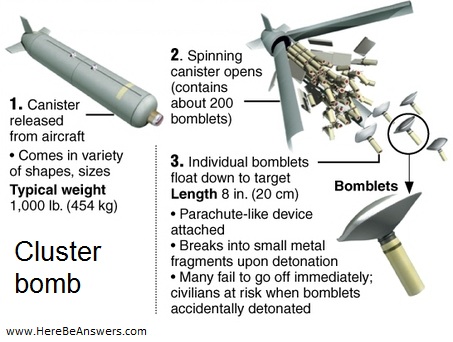

| Online: | |
| Visits: | |
| Stories: |

| Story Views | |
| Now: | |
| Last Hour: | |
| Last 24 Hours: | |
| Total: | |
American War Crimes? U.S. Using Outlawed Cluster Bombs in Syria and Yemen
SOURCE: http://www.blacklistednews.com/U.S._Cluster_Bomb_Use_Goes_Unabated_in_Yemen_and_Syria/53881/0/38/38/Y/M.html
One of the biggest tragedies of cluster bombs is that the ones that don’t explode lie around for kids to pick up later… and they do!
Cluster bombs, which have been used since World War II to kill and maim indiscriminately, were outlawed under an international treaty that was adopted in 2008.
Most of the world’s countries have signed the treaty, but not the United States and Russia, where many of the bombs were made. A report released Thursday in Geneva found that the weapons continued to be used with near impunity in the conflicts in Syria and Yemen.
In Syria, at least 13 kinds of cluster munitions — dropped from the air or launched from the ground — have been used since 2012, said the report, the seventh annual Cluster Munition Monitor (pdf) , which found “compelling evidence” that Russia had used the weapons since the start of its military intervention last September in support of Syria’s embattled government.
In Yemen, seven kinds of cluster munitions were used in 19 attacks from April 2015 to February of this year as part of the Saudi-led coalition’s fight against Shiite Houthi rebels, the report found. Saudi Arabia, which has not signed the treaty, has acknowledged using the munitions once, in April 2015. Most of the cluster bombs used in Yemen originated in three countries: the United States, Britain and Brazil.
The report also found “strong but unconfirmed evidence” that cluster munitions had been used in April during a brief skirmish in the contested Nagorno-Karabakh region between Armenia and Azerbaijan; both countries denied using them.
Except for a single 2009 strike in Yemen, the United States has not used cluster bombs since 2003, and has not budgeted funds to acquire new cluster munitions since 2007. A Defense Department policy requires that use of cluster munitions with a failure rate of greater than 1 percent be phased out by 2018. The policy also states that countries that receive such munitions from the United States may not use them in civilian areas, but the report cast doubt on whether that requirement has been met.




Outlawed? So what? Whom is going to enforce it? UNcle never signed the Geneva Accords on the use of chemical weapons either.